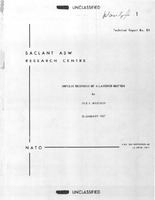| dc.contributor.author | Hastrup, Ole F. | |
| dc.date.accessioned | 2018-10-11T14:07:42Z | |
| dc.date.available | 2018-10-11T14:07:42Z | |
| dc.date.issued | 1967/01 | |
| dc.identifier | 2382 | |
| dc.identifier.govdoc | TR-85 | |
| dc.identifier.uri | http://hdl.handle.net/20.500.12489/353 | |
| dc.description.abstract | Numerical methods are used for the Fourier inversion of the frequency-dependent loss transfer function. Because of the non-zero finite values of the integrand for an infinite high frequency, the asymptotic value is subtracted from the integral, thereby making it possible to use a finite truncation frequency, and frequency increment is shown in graphs. The impulse response is calculated at several angles of incidence for typical two and three layer models and is shown in graphs. | |
| dc.format | i, 30 p. : ill. | |
| dc.language | English | |
| dc.publisher | NATO. SACLANTCEN | |
| dc.relation.ispartofseries | AD0811104 | |
| dc.subject | Acoustic reflection | |
| dc.subject | Acoustic reflection loss | |
| dc.subject | Seafloor | |
| dc.subject | Fourier transformations | |
| dc.subject | Underwater acoustics | |
| dc.title | Impulse response of a layered bottom | |
| dc.type | Scientific Technical reports (TR) | |
